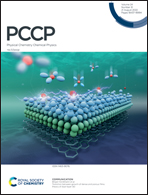Effects of ice and supercooled water on the metastability of methane hydrate: DSC analysis and MD simulations†
Abstract
Methane hydrate (MH) has been viewed as a potential abundant clean energy resource worldwide. Its related technologies play important roles in applications of gas and energy storage, flow assurance of natural gas pipelines etc. Unlike the well-researched stability and decomposition of MH at temperatures above 273 K, the metastability of MH below the ice freezing point, i.e. the anomalous slow decomposition out of thermodynamically stable regions, remains to be unravelled. Studies regarding the influences of ice and supercooled water (SW) on the metastable properties of MH led to varied conclusions, i.e. the as-proposed self-preservation effect and metastable MH–SW–gas equilibrium. In this study, a series of DSC experiments were performed to investigate the thermal stability boundaries and the associated metastable behaviours of MH–ice–gas and MH–SW–gas samples in porous medium. The DSC analysis probed accurate thermal stabilities and characterized decomposition behaviors of the samples, contributing to the hypothesis of potential influences from SW and ice on the metastability of MH. MD simulations were also validated and performed. Active guest–host interactions by the SW layers between MH and gas phases were identified, suggesting probable microscopic configurations related to the metastability of the MH–SW–gas system. Indications of the DSC and MD simulation results call for future high-resolution in situ experimental validations.



 Please wait while we load your content...
Please wait while we load your content...